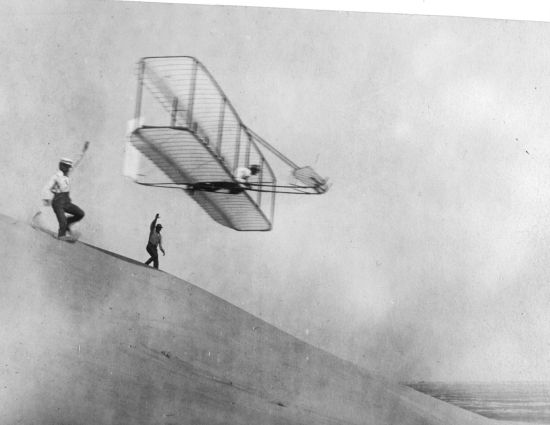
What struck me was that, the Wright Brothers were not scientists. They were inventors.
Their background was running a bicycle shop, and they operated on limited funds.
Others working on the issues of flight were wealthy or government-funded: Ader, Maxim, Langley and Santos-Dumont. Samuel Pierpont Langley, the nation's "foremost scientist" had received more than $50,000 in government funds to create his man-carrying Great Langley Aerodrome, which plunged twice into the Potomac River.
The Wright Flyer however, cost less than $1000.00 to build.
The real success of the Wright Flyer was the control mechanisms. Many had experimented with gliders. And so many had crashed because they could not control the machine.
"The brothers' fundamental breakthrough was their invention of three-axis control, which enabled the pilot to steer the aircraft effectively and to maintain its equilibrium. This method became standard and remains standard on fixed-wing aircraft of all kinds. From the beginning of their aeronautical work, the Wright brothers focused on unlocking the secrets of control to conquer 'the flying problem', rather than developing more powerful engines as some other experimenters did. Their careful wind tunnel tests produced better aeronautical data than any before, enabling them to design and build wings and propellers more effective than any before. Their U.S. patent 821,393 claims the invention of a system of aerodynamic control that manipulates a flying machine's surfaces."
They did a lot of systematic and scientific testing. Not unlike I do in tech.
Most of their development was to build gliders that could fly and be successfully controlled. They cautiously didn't even man them, but flew them like a kite, controlling them by cords from the ground.
"They built a six-foot wind tunnel in their shop and conducted systematic tests on miniature wings from October to December 1901. … The devices allowed the brothers to balance lift against drag and accurately calculate the performance of each wing. They could also see which wings worked well as they looked through the viewing window in the top of the tunnel."
"The Wrights took a huge step forward and made basic wind tunnel tests on 200 wings of many shapes and airfoil curves, followed by detailed tests on 38 of them. The tests, according to biographer Howard, 'were the most crucial and fruitful aeronautical experiments ever conducted in so short a time with so few materials and at so little expense'. An important discovery was the benefit of longer narrower wings: in aeronautical terms, wings with a larger aspect ratio (wingspan divided by chord—the wing's front-to-back dimension). Such shapes offered much better lift-to-drag ratio than the broader wings the brothers had tried so far."
They questioned the constant for the Smeaton coefficient equation that had been around for 100 years. "The Wrights—and Lilienthal—used the equation to calculate the amount of lift that wings of various sizes would produce. Based on measurements of lift and wind during the 1901 glider's kite and free flights, Wilbur believed (correctly, as tests later showed) that the Smeaton number was very close to 0.0033, not the traditionally used 60 percent larger 0.0054, which would exaggerate predicted lift."
Smart! And truly scientific. Look at the data, and make inferences from the data. Not the other way around: attempting to make the data fit a preconceived notion.
I doubt any venture capitalist would fund them today. The Wright Brothers don't fit the "profile": a masters degree and a consistent history of other business and career successes.
Yet, they successfully developed one of the most important and influential inventions of the modern world.
No comments:
Post a Comment